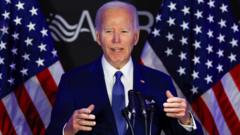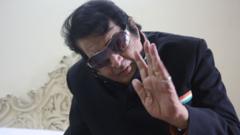As India, now the world’s most populous country, navigates the complexities of declining fertility and an aging populace, southern states advocate for increased childbearing to mitigate potential socio-economic and electoral repercussions.
South India’s Dilemma: Balancing Population Growth and Aging Concerns

South India’s Dilemma: Balancing Population Growth and Aging Concerns
Southern Indian states are grappling with low fertility rates while facing calls for increased birth rates, raising tensions over future demographics and aging populations.
The landscape of population dynamics in India is shifting dramatically, particularly in the southern states of Andhra Pradesh and Tamil Nadu, where leaders are actively encouraging families to have more children. Despite housing nearly 1.45 billion people and having officially overtaken China as the world's most populous nation, these states emphasize the urgency of growing their demographics as a buffer against an impending aging crisis.
Both Andhra Pradesh and Tamil Nadu are expressing concerns about declining fertility rates, coupled with the implications of an aging population. The fertility rate in India has plummeted from 5.7 births per woman in 1950 to the replacement level of approximately two. Yet, several southern states, which have already surpassed that benchmark, are witnessing fertility rates plummet even further, prompting state leaders to consider dismantling previous two-child policies to incentivize growth.
The demographic shifts are significant—while Kerala reached a total fertility rate of 1.6 in 1988, Tamil Nadu's rate is currently at 1.4, similar to some European nations. These southern regions are worried that a lack of population growth will distort electoral representation and federal funding allocations, especially as India approaches its first delimitation exercise since 1976, aiming to adjust parliamentary seats to reflect new population distributions by 2026.
Demographic experts highlight the economic ramifications behind this demographic shift, warning that populous northern states like Uttar Pradesh and Bihar might gain political leverage while wealthier southern states may see their power diminish. This, they warn, could deepen economic disparities as parliamentary representation and federal revenues will be concentrated toward states with burgeoning populations.
India is facing a unique challenge: its rapid aging process. Projections indicate that while countries like France and Sweden took over a century to double their aging population from 7% to 14%, India will achieve this in just 28 years. This trend strains economic resources, as a growing elderly population may further burden already stressed social systems.
As public discourse around increased childbearing intensifies, figures such as Mohan Bhagwat, leader of the Rashtriya Swayamsevak Sangh, have implored couples to consider larger families to secure India's future. However, demographers argue that artificially inflating birth rates will not be a sustainable solution, as changing societal norms and women's increasing participation in the workforce are likely to persist as barriers to larger families.
The road ahead for Indian states grappling with low birth rates may require creative solutions: policymakers could explore extending retirement ages and harnessing the potential of an aging workforce. As experts call for robust investments in health care and social infrastructure, there remains an opportunity for India to better utilize its demographic dividend before facing the challenges of population decline.
With nuanced strategies addressing both growth and the impending aging crisis, southern India's response to these complex demographic dynamics will ultimately dictate the socio-economic landscape of the world's largest democracy.






















